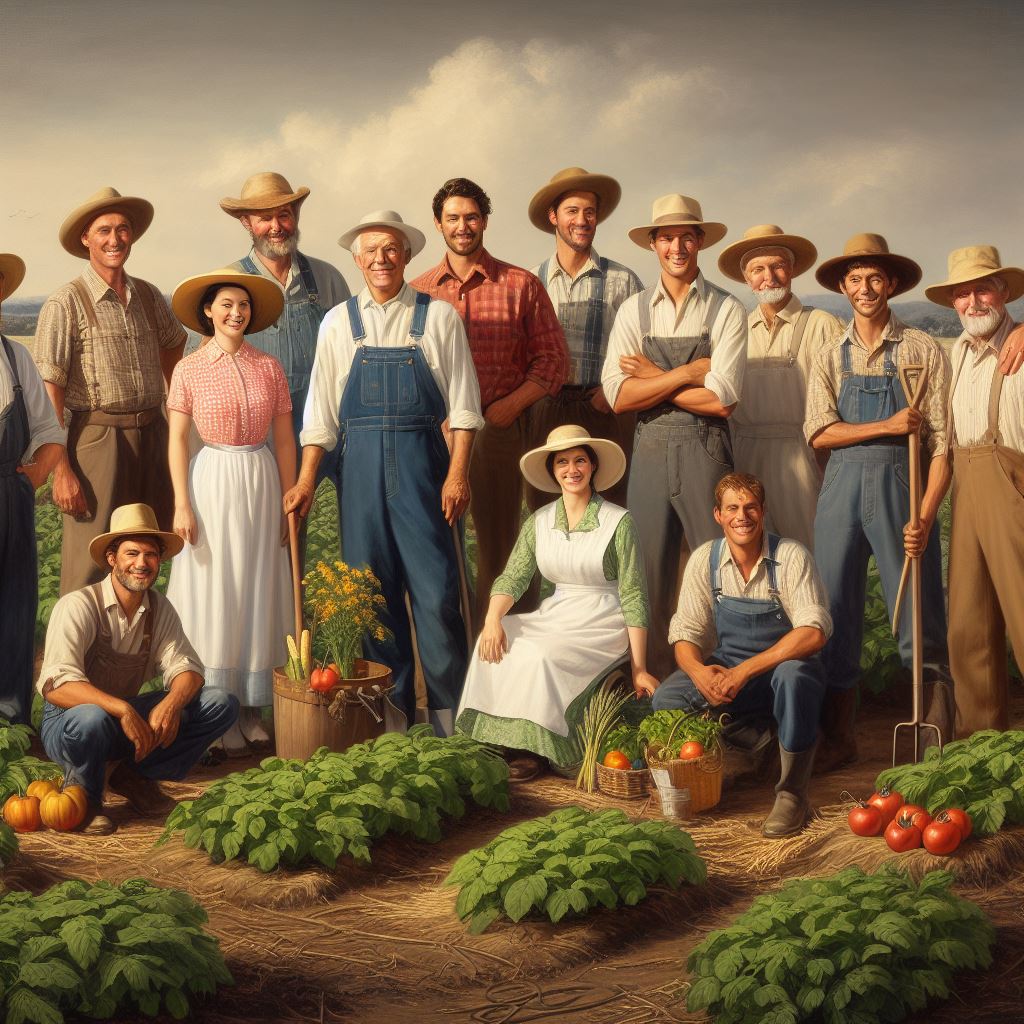Community Supported Agriculture (CSA) 101
Last Updated on March 2, 2024
Introduction
Community Supported Agriculture (CSA) is a popular model where members support local farms by purchasing shares.
Embark on a journey into the heart of sustainable farming with Community Supported Agriculture (CSA).
As our culinary landscapes evolve, so does the awareness of the origins of our food. C
CSA has gained importance because it promotes sustainable farming practices and offers benefits like fresh, seasonal produce and a closer connection to the food source.
CSA stands as a beacon, forging a direct link between communities and local farmers.
This blog post aims to provide an introduction to CSA, define its concept, highlight its significance, and explain the purpose of the post.
In this exploration, we unravel the intricacies of CSA, an innovative model that redefines the way we procure and appreciate our produce.
CSA goes beyond the conventional transactional exchange; it’s a partnership, a commitment to the land, and a pledge to support local agriculture.
This introduction delves into the core principles of CSA, illuminating its profound impact on food sustainability, community well-being, and the overall richness of our gastronomic experiences.
Join us as we navigate the fundamentals, benefits, and the vibrant tapestry of connections that flourish within the realm of Community Supported Agriculture.
Let’s dive in and explore the world of Community Supported Agriculture!
How CSA Works
Explanation of CSA concept
Community Supported Agriculture (CSA) is a system where consumers directly support local farmers.
In CSA, consumers become members of a farm by purchasing a share of its produce.
The concept aims to create a mutually beneficial relationship between farmers and consumers.
Farmers receive financial support upfront, allowing them to plan and cultivate crops more effectively.
In return, consumers receive a regular supply of fresh, organic, and locally grown produce throughout the season.
CSA promotes a stronger connection between farmers and the community, fostering a sense of shared responsibility.
Farmers’ responsibilities in CSA
- Farmers play a crucial role in CSA by growing a diverse range of crops on their farms.
- They are responsible for cultivating, harvesting, and preparing the produce for distribution.
- Farmers must ensure that the crops are grown using organic and sustainable farming practices.
- They need to communicate with CSA members, informing them about the farm’s progress and any challenges.
- Farmers also organize pickup or delivery options for the consumers to receive their share of produce.
- It is essential for farmers to maintain transparency and keep the CSA members engaged throughout the season.
- Farmers may also provide additional benefits like farm tours or educational events for the members to enhance their experience.
Consumers’ responsibilities in CSA
- Consumers who participate in CSA have certain responsibilities to support the success of the program.
- They need to purchase a share or membership from the farm at the beginning of the season.
- Consumers should understand and accept the risks associated with farming, including crop failures or weather impacts.
- It is crucial for consumers to commit to picking up their share of produce regularly or arranging alternative solutions.
- Consumers must be willing to try new varieties of vegetables and fruits that may be part of the CSA share.
- Feedback from consumers is valuable, as it helps farmers understand consumer preferences and improve their farming practices.
- Consumers should also appreciate the seasonal nature of CSA, understanding that not all produce may be available year-round.
- Being part of a CSA means supporting local agriculture, so consumers should spread the word and encourage others to join.
In Community Supported Agriculture, farmers and consumers come together to create a sustainable and mutually beneficial system.
By understanding the responsibilities of both parties, CSA can thrive and contribute to a healthier and more connected community.
Farmers’ dedication to organic farming and communication, combined with consumers’ commitment to supporting local agriculture, make CSA a powerful movement.
Joining a CSA is not just about receiving fresh produce; it’s about becoming an active participant in supporting local farmers and strengthening the bond between the community and the food they eat.
Advantages of CSA
A Community Supported Agriculture (CSA) program offers various advantages that support both consumers and local farmers.
Access to fresh and local produce
By participating in a CSA program, individuals gain access to fresh and locally grown produce.
The fruits and vegetables are harvested at the peak of their flavor and nutritional value, ensuring a much higher quality compared to those found in supermarkets.
Consumers can enjoy a wide variety of seasonal produce that may not be readily available in grocery stores.
This allows for a more diverse and nutritious diet.
Furthermore, CSA members often have the opportunity to visit the farm and witness the growing process firsthand.
This connection to the source of their food deepens their appreciation for the agriculture and the hard work of local farmers.
Support for local farmers and the economy
When individuals participate in a CSA, they directly support local farmers and their livelihoods.
CSA programs provide a stable income for farmers by offering upfront payments or subscriptions, which allows them to plan their operations with more certainty.
This financial stability enables farmers to invest in equipment, maintain their land, hire employees, and expand their operations.
By supporting local farmers, CSA members play a crucial role in preserving farmland and rural communities.
Moreover, when consumers choose locally grown produce over products that are shipped from distant locations, their money stays within the local economy.
This leads to increased economic opportunity and a stronger community.
Environmental benefits
CSA programs promote sustainable and environmentally friendly practices.
Local farmers often prioritize organic or low-pesticide methods of cultivation, minimizing the use of harmful chemicals that can contaminate water sources and harm wildlife.
Additionally, CSA reduces the carbon footprint associated with long-distance transportation.
By purchasing food that has been grown locally, consumers contribute to reducing greenhouse gas emissions caused by the transportation of goods.
CSA members also benefit from reduced packaging since the produce is often delivered in reusable or recyclable containers.
This contributes to the overall goal of reducing waste and promoting a greener lifestyle.
In essence, participating in a Community Supported Agriculture program offers a multitude of advantages.
Members gain access to fresh and local produce, support local farmers and the economy, and contribute to environmental sustainability.
By becoming part of a CSA, individuals can make a positive impact on their own well-being, the community, and the planet.
Read: Cooking Tips: From Farm Produce to Plate
Types of CSA Programs
Traditional CSA model
In the traditional CSA model, consumers purchase a share of the farm’s harvest in advance.
Members receive a predetermined selection of fresh produce each week throughout the growing season.
This model fosters a strong connection between farmers and consumers, promoting a sense of community.
Farmer’s market CSA
Farmer’s market CSA programs allow members to pick up their shares directly from the farmer at a local market.
This type of CSA offers the convenience of selecting additional produce and products while supporting local farmers.
Members can engage with the farmer, learn about the produce, and ask questions about farming practices.
Multi-farm CSA
Multi-farm CSA programs collaborate with multiple local farms to provide a diverse range of produce.
This model allows farmers to specialize in certain crops while ensuring members receive a variety of fresh products.
Members enjoy the convenience of receiving a wider selection of produce without having to visit multiple farms.
Co-op CSA
Co-op CSA programs involve a group of households who collectively support one or more farms.
Members share the responsibilities of running the CSA, such as organizing deliveries and coordinating with farmers.
This model promotes a strong sense of community and enables members to actively participate in the operation of the CSA.
CSA programs come in various types, each offering unique benefits and opportunities for consumers and farmers.
The traditional CSA model ensures a direct link between consumers and the farm, fostering a sense of trust and connection.
On the other hand, farmer’s market CSA programs allow members to interact personally with farmers and have greater control over their selection.
Multi-farm CSAs provide a diverse range of produce, supporting multiple local farms and enhancing variety.
Finally, co-op CSAs encourage community involvement and shared responsibilities among members and farmers.
When choosing a CSA program, consider your preferences, lifestyle, and goals.
If you value a direct connection with a specific farm and want to support them directly, a traditional CSA might be suitable.
However, if you prefer more flexibility in product selection and enjoy interacting with farmers, a farmer’s market CSA may be a better fit.
Those seeking a broader variety of produce without visiting multiple farms should explore multi-farm CSAs.
Alternatively, if community involvement and shared responsibility are important to you, consider joining a co-op CSA.
Regardless of the type of CSA program you choose, supporting local agriculture has numerous benefits.
By purchasing a CSA share, you directly contribute to the success of small-scale farmers and sustainable agricultural practices.
Moreover, CSA programs often provide organic and freshly harvested produce, promoting a healthier diet for you and your family.
Joining a CSA can also serve as a valuable learning experience, allowing you to deepen your understanding of farming and food production.
In general, CSA programs offer a fantastic opportunity to engage with local agriculture, support small-scale farmers, and enjoy fresh, seasonal produce.
Whether you prefer the traditional, farmer’s market, multi-farm, or co-op model, there is a CSA program out there for everyone.
Read: Farmers Markets: Your Local Food Hub

Choosing a CSA Program
Factors to consider when choosing a CSA
When it comes to participating in a Community Supported Agriculture (CSA) program, not all farms are created equal.
Therefore, it is essential to carefully select the CSA that best fits your needs and preferences. Here are some factors to consider when choosing a CSA program:
Pick-up/delivery options
One crucial aspect to consider is how and where you will receive your CSA share.
Some CSAs require you to pick up your produce directly from the farm or a predetermined location, while others offer home delivery options.
Assess which pick-up or delivery method is most convenient for you before making a decision.
Crop variety and availability
CSAs vary in the types and quantities of crops they grow. Consider the variety of produce included in the CSA shares and whether they align with your preferences.
Additionally, inquire about the CSA’s ability to provide a consistent supply throughout the growing season.
After all, you wouldn’t want to end up with limited options or scarcity of certain crops.
Cost and payment options
Cost is an important factor to consider when choosing a CSA. Assess the subscription fee to ensure it falls within your budget.
Some CSAs offer different share sizes, allowing you to choose the option that best suits your needs. Additionally, inquire about payment options.
Do they offer installment plans or discounts for early sign-ups? Make sure the CSA’s payment structure aligns with your financial capabilities.
Farming practices and certifications
The farming practices employed by the CSA should align with your values.
Research the CSA’s methods to ensure they follow sustainable and environmentally friendly practices.
Look for CSAs that prioritize organic farming or utilize integrated pest management techniques.
Additionally, inquire about any certifications the CSA holds, such as USDA organic certification or food safety certifications.
Supporting farms with these certifications promotes ethical and responsible agriculture.
By taking these factors into account, you can make an informed decision and choose a CSA program that meets your needs and values.
Remember to research multiple CSAs in your area, read reviews, and even visit the farm if possible.
Engaging in a CSA program not only provides you with fresh and seasonal produce but also supports local farmers and fosters a sense of community.
Read: Sustainable Practices in Farm-to-Table
Joining a CSA
A Community Supported Agriculture (CSA) is a great way for individuals to support local farmers and have access to fresh, organic produce.
Joining a CSA is a simple process that involves finding local CSAs, contacting them to ask questions, and signing up to become a member.
Finding local CSAs
- Start by researching local CSAs in your area. Use online directories or ask friends and neighbors for recommendations.
- Look for CSAs that align with your values and preferences, such as organic farming practices or specific types of produce.
- Consider the distance from the farm to your location, as some CSAs may require you to pick up your produce directly from the farm.
Contacting the CSA and asking questions
- Once you have identified potential CSAs, reach out to them via phone or email to inquire about their CSA program.
- Prepare a list of questions to ask, including the cost of membership, duration of the CSA season, and pick-up or delivery options.
- Ask about the types of produce they offer and whether they provide any additional benefits, such as recipes or newsletters.
- Inquire about their farming practices, such as pesticide use or the use of sustainable farming methods.
Signing up and becoming a member
- After gathering the necessary information, choose the CSA that best fits your needs and values.
- Follow the instructions provided by the CSA to sign up and become a member.
- Pay the required membership fee, which usually covers the cost of a share in the farm’s produce for the season.
- Be aware of any additional commitments or expectations, such as volunteer hours or participation in farm events.
- Provide any necessary personal information, such as your contact details and dietary restrictions, to ensure a smooth membership experience.
Consider joining with a friend or neighbor to share the cost and responsibility of the CSA membership.
By joining a CSA, you become an active participant in your local food system, supporting sustainable agriculture and enjoying the benefits of fresh, seasonal produce.
Make sure to stay engaged with the CSA throughout the season, attend events, and provide feedback to further strengthen your community and the CSA’s impact.
Read: Farm-to-Fork: Understanding the Chain
Member Responsibilities
Community Supported Agriculture (CSA) is all about building a strong relationship between farmers and consumers.
As a member of a CSA, you have certain responsibilities that ensure the success of the program. Here are some important tasks you need to fulfill:
Picking up weekly shares
One of the primary responsibilities of CSA members is to pick up their weekly share of produce.
This ensures that the fresh and seasonal vegetables, fruits, and other agricultural products are not wasted and are enjoyed by the members.
- Arrive on time to the designated pick-up location.
- Bring your own bags or containers to carry your share.
- Respect the pick-up schedule and notify the farmer in case of any changes or inability to pick up.
- Check your share carefully for any damages or discrepancies.
Communicating with the farmer
Efficient communication between CSA members and farmers is crucial for the smooth functioning of the program.
By keeping the farmers informed, you contribute to the overall success and productivity of the CSA.
- Provide accurate contact information and update the farmer about any changes.
- Notify the farmer about any allergies or dietary restrictions.
- Ask questions, seek clarifications, and express any concerns or suggestions you may have.
- Share recipes, cooking tips, and success stories with the farmer and other members.
Providing feedback and suggestions
Your feedback and suggestions play a vital role in helping the farmer improve and cater to the preferences and needs of the members.
Be proactive in providing your valuable input to enhance the CSA experience.
- Give feedback on the quality, quantity, and variety of the produce received.
- Suggest specific crops or products you would like to see in your share.
- Share your thoughts on the overall organization and management of the CSA program.
- Participate in surveys or meetings organized by the farmer to gather feedback from members.
By fulfilling these member responsibilities, you contribute to the success and sustainability of your CSA.
Remember, CSA is a partnership between farmers and consumers, and your active involvement and support are crucial for its continued growth.
Together, we can foster a sense of community and promote a healthier and more sustainable way of eating.
Making the Most of Your CSA
CSA programs offer a unique opportunity to connect with local farmers, support sustainable agriculture, and enjoy fresh, seasonal produce.
However, subscribing to a CSA also comes with the responsibility of making the most of the weekly farm share.
By incorporating meal planning, preserving excess produce, and sharing the CSA experience with others, you can fully maximize the benefits of your membership.
Meal planning with CSA produce
Meal planning is key to utilizing your CSA produce effectively. Instead of letting items go to waste, take the time to plan your weekly menu around the contents of your CSA box.
Be willing to try new recipes and experiment with different cooking methods to make the most of the fresh ingredients.
Whether it’s roasting vegetables, grilling fruit kebabs, or sautéing greens, exploring various cooking techniques can enhance the flavors of your CSA produce.
Preserving and storing excess produce
If you find yourself with excess produce, don’t fret. There are plenty of ways to preserve and store it for later use.
Freezing is a popular method for fruits and vegetables that can be blanched or chopped before freezing.
You can also turn excess cucumbers, beets, or green beans into delicious pickles.
Consider making jams or jellies with seasonal fruits to enjoy their flavors throughout the year.
Investing in canning equipment allows you to create pantry staples like tomato sauce or salsa using your CSA bounty.
Sharing the CSA experience with others
Sharing your CSA experience with others is not only fun but also a fantastic way to spread the word about the benefits of local agriculture.
Invite friends, family, and neighbors to visit the farm where your CSA operates.
Organize a cooking party or potluck where everyone contributes a dish made with CSA produce.
Sharing recipes and tips with others encourages creative utilization of CSA items and helps reduce food waste.
By inspiring others to support local farms and join CSA programs, you contribute to building a sustainable and vibrant community.
In summary, making the most of your CSA membership involves meal planning, preserving excess produce, and sharing the experience with others.
By taking advantage of the variety and freshness of your weekly farm share, you not only enjoy delicious meals but also support local agriculture and foster a sense of community.
Embrace the bounty of your CSA and savor the benefits it brings to your table and beyond.
Learn More: Sustainable Eating: Farm-to-Fork Focus
Conclusion
Let’s recap the key points we discussed about Community Supported Agriculture (CSA) 101.
CSA is a farming model where farmers sell shares of their harvest directly to consumers.
It strengthens the bond between farmers and consumers, fostering a sense of community and support.
CSA members receive a weekly share of fresh and seasonal produce, supporting sustainable agriculture practices.
Our blog post aimed to encourage you to explore and join a CSA program.
Joining a CSA offers numerous benefits, such as getting access to fresh, locally grown produce and supporting local farmers.
By becoming a CSA member, you contribute to the sustainability of small-scale agriculture and promote food security.
We hope this post has sparked your interest in CSA programs and helped you understand their importance.
If you have any comments or questions about CSAs, we invite you to leave them below.
Thank you for reading and taking the first step towards a more sustainable and community-driven food system!


